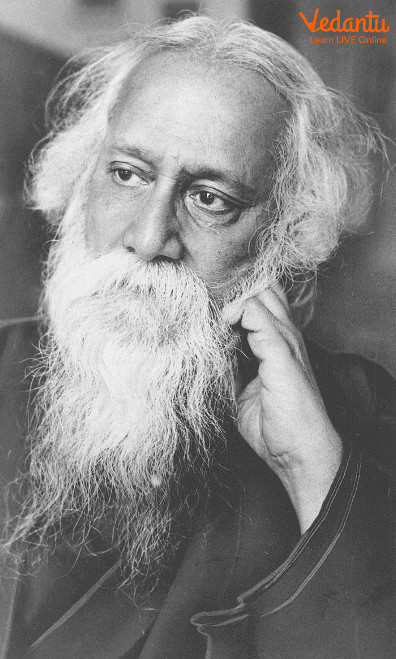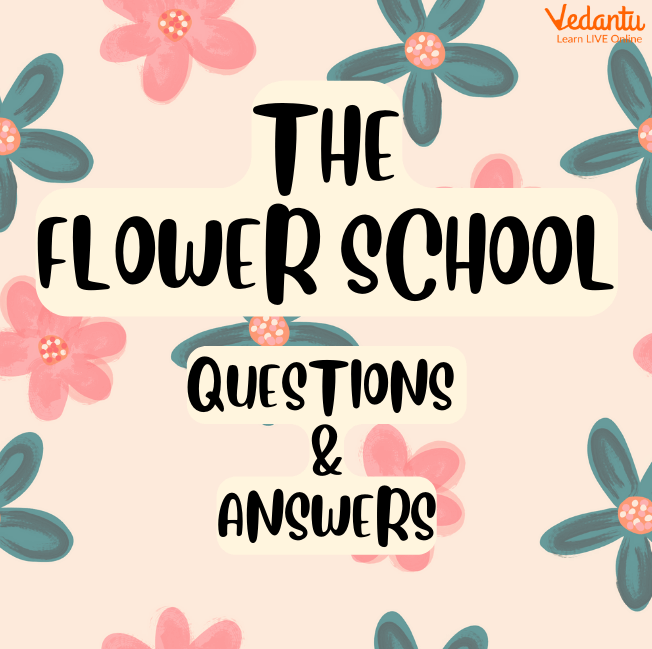About the Poem: The Flower-School
Rabindranath Tagore is a famous Bengali author who won India's first (and so far only) Nobel Prize in Literature. The poet conveys the delight and excitement of the blossoming of flowers with the advent of rains through the naive eyes of a school-aged youngster. Everyone's heart is touched by the innocent depiction of the seasonal appearance and departure of flowers on and off the face of the earth. This short poem depicts a child's interest in flowers, her fear of school, and her love for her mother with remarkable realism. This is why this short poem has its timeless appeal.
Read through to know more about this beautiful poetic piece.

Rabindranath Tagore
The Poem: The Flower-School
When storm-clouds rumble in the sky and June showers come down,
The moist east wind comes marching over the heath to blow its bagpipes among the bamboos.
Then crowds of flowers come out of a sudden,
from nobody knows where, and dance upon the grass in wild glee.
Mother; I really think the flowers go to school underground.
They do their lessons with doors shut, and if
they want to come out to play before it is time,
their master makes them stand in a corner.
When the rains come they have their holidays.
Branches clash together in the forest, and the
leaves rustle in the wild wind, the thunder-clouds
clap their giant hands and the flower children
rush out in dresses of pink and yellow and white.
Do you know, Mother, their home is in the sky, where the stars are.
Haven't you seen how eager they are to get there? Don't you know why they are in such a hurry?
Of course, I can guess to whom they raise their arms;
they have their mother as I have my own.
Summary of the Poem ‘The Flower-School’
Rabindranath Tagore's poem "The Flower-School" was written in Bengali. It's told in the third person, yet there are parts where a child speaks to his mother. Moisture-laden gusts from the east brush through the bushes with remarkable speed when storm clouds burst and rains begin to pour from the sky in June. From the bamboo bushes comes a piercing sound. As the seasonal flowers emerge with incredible glee, a large carpet of yellow-coloured small blossoms appears to plummet down on the grass. The little flowers appear to go underground to accomplish their home responsibilities before appearing on the grasses.
They only venture out into the open after they have completed their tasks. Flowers do not dare to bloom early on the land, much as a child is pulled up for going to class with incomplete homework. The poet's comparison of wild flowers to school children is nothing more than a very creative figment of his imagination. It is pretty accurate and entertaining for the readers. The onset of the rain provides some relief from studying. The flowers burst forth into the open with the same enthusiasm with which students greet the start of the holidays.
Question Answer on the Poem ‘The Flower-School’
Read the poem in mind and answer the below given questions.

The Flower-School poem
1. What is the theme of the poem?
Answer: The poem describes the flowers as a beautiful creation of God. This is a clear description of budding flowers and also their growth in the Spring season.
2. What rumbles in the sky?
Answer: The storm clouds rumble in the sky.
3. What is it that is moving across the heath?
Answer: A moist east wind blows through the health.
4. Which word indicates that the east wind is not dry?
Answer: Moist is the answer.
5. What causes the damp east wind?
Answer: The damp east wind blows in a marching motion.
6. How do the flower crowds appear?
Answer: All of a sudden, a swarm of flowers appears.
7. Where and how do the flowers dance?
Answer: The flowers are joyfully dancing on the grass.
8. In the poem, which season is described?
Answer: The poet describes the spring season in the poem.
9. Where do you find flowers all year?
Answer: The flowers can be found underground at their school.
10. To whom are the flowers likened?
Answer: The flowers are comparable to primary school students.
11. What method do they use to deliver their lessons? Why?
Answer: With the doors locked, the flowers learn their lesson. It is due to the fact that they live a disciplined lifestyle.
12. Who is referred to as "their master"?
Answer: The teacher of the small flowers is referred to as their master.
13. Do they have a strict or lenient master? Which sentence of the poem confirms this?
Answer: Their lord is strict, to say the least. We know this since the statement "master makes them stand in a comer" says so.
14. How long will they be forced to stand in a corner?
Answer: The flowers are made to stand in a corner if they come out to play before it is time.
15. When do the flowers go on vacation?
Answer: When the rains come, the flowers take a break.
16. What happens in nature when it rains?
Answer: When it rains, the branches of trees clash, the leaves ruffle in the wind, and thunderstorms occur. The brightly coloured tiny flowers join in the fun.
17. How do the flower kids spend their vacations?
Answer: In pink, yellow, and white outfits, the colourful little flowers emerge to play.
18. With whom is the speaker exchanging ideas?
Answer: The speaker is talking to his mother about his feelings.
19. What is the location of the flower children's home?
Answer: The flower children's house is in the sky, according to the answer.
20. What makes them so ready to fly?
Answer: They want to meet their mother who lives in the sky, so they are very excited to go there.
Conclusion
Tagore’s poems, especially those meant for children, always make for a beautiful read. His creative imagination and use of words are sure to tickle your child’s thought process and expand their vocabulary. This poem exemplifies the relationship between nature and humankind. When kids read this poem, they will be able to relate to it much as it also entails a conversation between a mother and a child. We hope you have enjoyed reading this beautiful poem by Rabindranath Tagore. You can visit our website to access more of such wonderful poems by prominent writers.


FAQs on The Flower-School Poem - Summary, Question And Answers
1. What makes you think the flowers are happy as they dance across the grass?
Storm clouds gather in the sky, and a wet east wind blows, ushering in the first rain showers. Flowers have been compared to small school children, with the rainy season serving as a time for them to take vacations. As a result, they gleefully dance on the grass.
2. Do you believe the speaker believes that vacations are more enjoyable than school days?
Yes, the speaker believes that vacations are more enjoyable than school days. It's because boarding school students visit their homes and see their family members. They also meet their mother, whom they adore.





